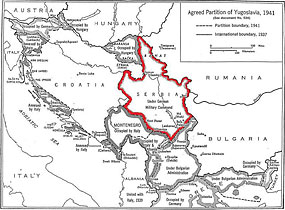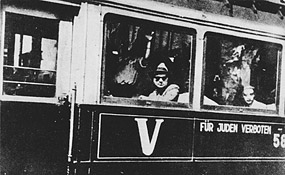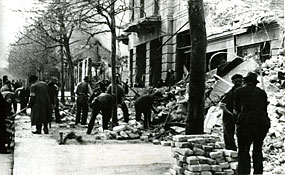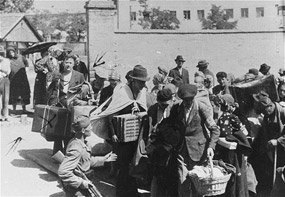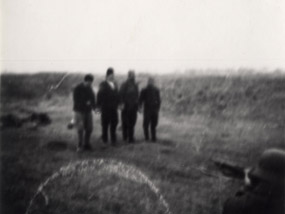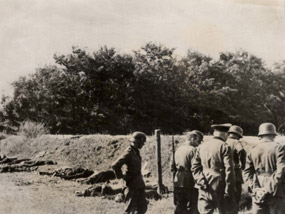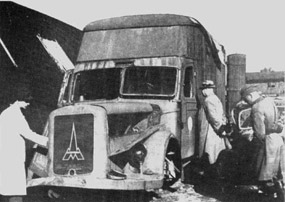English | Srpski
Holocaust in Serbia
On 27 March 1941, the day after the head of the Yugoslav government Dragiša Cvetković signed a Tripartite Pact which committed the country to an alliance with the Axis, a group of Yugoslav Army Officers, led by General Dušan Simović carried out a coup d'etat and annulled the treaty with Hitler. Simović's actions were followed by mass demonstrations in Belgrade in support of the coup. Ten days later, Germany launched the invasion of Yugoslavia with an immense dawn aerial attack on Belgrade on 6 April. The bombing of the capital destroyed large proportions of the city and left between two and three thousand civilians dead and many more thousands wounded. After a brief, eleven-day war the disorganised and poorly prepared Yugoslav Army capitulated.
Within days of the official surrender on 17 April, Yugoslavia was carved up by Nazi Germany and its allies. Substantial parts of Serbia were annexed to Hungary (the region of Bačka), Bulgaria (area to the south of Leskovac, Vranje and Pirot), Italy (large parts of Kosovo), and the newly formed Nazi ally, The Independent State of Croatia (the region of Srem, up to the most easterly point, the left bank of the River Sava in Belgrade). The rest of Serbia was placed under direct German administration. After a dispute between Hungary, Rumania and the leadership of the indigenous Volksdeutcher community over the control of the northern region of Banat, this territory was given the status of an 'autonomous administrative unit' within Nazi occupied Serbia.
From the very first day of the occupation the Jewish communities in Serbia and Banat were subjected to various policies of registration, pauperisation and social exclusion. As early as on the 13th April 1941, even before the Yugoslav Army formally capitulated, Wilhelm Fuchs - Chief of the Einsatzgruppen based in Belgrade - ordered the registration of the city's Jews. Shortly after, the Field Commander Colonel von Keisenberg, issued a decree which limited their freedom of movement. [1] On 29th April 1941, the newly appointed Chief of the Military Administration in Serbia, Harald Turner issued the first formal order concerning the registration of all Jews and Gypsies throughout Serbia. The order, which began with the definition of Jews according to the established 'Losener principle', imposed severe restrictions on the daily life of those who fell within the category. It proscribed the wearing of yellow armbands, introduced forced labour and a night-time curfew, limited the access to food and other provisions and banned the use of public transport. [2]
Over the subsequent thirteen months, approximately 16.000 Jews were killed in Nazi occupied Serbia (including Banat). This number includes more than 11,000 Jewish citizens of Serbia proper, mainly from Belgrade, 3,800 Jews from Banat, and 1,100 Jewish refugees from central Europe (mainly Austria) whose prolonged flight to Palestine via Yugoslavia was brought to an end by the German attack on Yugoslavia in April 1941. The final death toll represents close to 90% of Serbia's pre-war Jewish population. The remainder survived either by joining The Partisans, fleeing to parts of Yugoslavia occupied by Italy, or through hiding in provincial towns and villages.
The destruction of Serbia's Jewry involved two distinct phases. The first, which lasted between July and November 1941 involved the murder of Jewish men, who were shot as part of The retaliatory executions (Geiselmordpolitik) carried out by the forces of the Wehrmacht in response to acts of insurgency and sabotage. The second phase between December 1941 and May 1942 involved the incarceration of the women and children at the Semlin Judenlager in Belgrade and their gassing in a mobile gas van.
The official order regarding the use of Jewish men as hostages in retaliatory shootings was formally issued in October 1941, although this had been regular practice since early days of the occupation. In fact, already in July, in anticipation of resistance from Serbian communists following Germany's attack on the Soviet Union, the Nazi authorities in Belgrade ordered the Jewish representative body (Vertretung der Judischen Gemainchaft) to supply 40 hostages weekly to be executed in reprisals for attacks on German forces. Hence, most public announcements relating to the reprisals which were issued at the time, referred to the executed hostages as comprising 'communists and Jews'. [3]
In late August 1941 the German authorities ordered the mass internment of Jewish men in the concentration camps in Belgrade (Topovske šupe) and in the city of Šabac. [4] The first detainees at the Topovske šupe camp - which was established in a former Yugoslav Army barracks on the outskirts of the capital - were some 1,500 male Jews who had been deported from Banat. They were soon followed by Jews from Belgrade. The camp at Šabac on the other hand was populated by a small number of local Jews and 1,100 Jewish refugees from Austria (including women and children) who had been stranded in the city since 1940.
The Nazi leadership's original intention was to solve the 'Jewish question' in Serbia by deporting the interned persons to the east. In early September, the German authorities (especially Harald Turner and the local German Foreign Office representative Felix Benzler) made several attempts to have the Jews deported to Romania, Russia or Poland. [5] However, suitable concentration camps had not yet been set up in Poland, and other potential destinations were still unwilling or insufficiently equipped to deal with deportees from Serbia. When advice on an alternative solution was sought from Berlin, the response simply stated: 'Eichmann proposes shooting'. [6] Firing squads - the method used against the Jews in Soviet lands, were also to be used in Serbia.
Over the next month, the number of Jewish interns in camps in Belgrade and Šabac diminished rapidly. Almost every day, truckloads of men were driven away to the execution grounds at Zasavica and Jabuka, where they were shot and buried in mass graves. Executions became more frequent after October 1941 when, in the face of the growing Partisan rebellion, the newly appointed plenipotentiary military commanding general Franz Böhme introduced what he called the 'measures of atonement': a formal order requiring the execution of 100 civilians for every German soldier killed and 50 for every wounded. Crucially, Böhme's order stipulated that populations from which hostages are to be drawn include 'all Communists, people suspected of being Communists, all Jews, and a given number of nationalist and democratically minded inhabitants'. [7] Thus, the first to be shot were the remaining Jewish interns in Šabac and Belgrade, suspected communist sympathizers incarcerated at the nearby Banjica camp and groups of Roma rounded up in and around Belgrade. The Serbian civilian population was targeted mainly in provincial towns and cities where the number of local Jews and imprisoned communists was insufficient to fill the required quota of hostages, or where the German army engaged in 'punitive expeditions' against specific villages or areas suspected of sheltering the Partisans. [8] During the two months of Böhme's mandate as military commander up to thirty thousand civilians had been shot in Serbia, including virtually all of Serbia's Jewish men.
The execution of interned Jews in Belgrade and Šabac in the context of the reprisal shootings can be said to have been motivated by a combination of ideological and practical concerns. In the minds of the Nazis, there was a natural identification between communist insurgents and Jews, making the Jews (along with suspected communists) an obvious choice of target for retaliatory executions. In late October 1941, at the height of the communist uprising, Harald Turner noted in a memorandum that hostages were to be drawn from among interned Jews and Gypsies, given that 'as a matter of principle', the two groups 'represent an element of insecurity and thus a danger to public order and safety'. [9] On the other hand, after the orders from Eichmann came through in September 1941, the reprisals became also an expedient means of dealing with the 'Jewish question'. As Harald Turner pointed out in his correspondence with Berlin, implementing Böhme's measures of atonement was 'not pleasant work' but 'The Jewish question solves itself most quickly in this way'. [10] At one point Turner reflected on the apparent illogicality of the policy of shooting Jewish hostages when retaliation should be 'at the expense of the Serbs' who were the main force behind the uprising, but he was able to rationalise this course of action by appealing to the issues of practicality ('they [the Jews] are the ones we have in the camp') and the apparent unavoidability of the 'final solution': 'besides, they are also Serbian citizens and they have to disappear'. [11] As one German soldier remembered after the war, 'the shooting of Jews bore no relation to the Partisan attacks': the retaliations merely provided 'an alibi for the extermination of the Jews'. [12]
The second phase of the Holocaust in Serbia - the destruction of the women and children - is dealt with in more detail in the sections on the history of the Semlin camp. In December 1941, approximately 5,000 Jewish women and children (including those from Banat who had been deported to the capital several months earlier) were interned in the Semlin Judenlager, a camp established in the pavilions of the former exhibition grounds, across the River Sava from downtown Belgrade. Over subsequent months, as Jews from provincial Serbia (including Šabac, Niš and Kosovska Mitrovica) were also deported to this camp, the number of inmates rose to close to 7,000.
During the harsh winter of 1941/1942 approximately 500 interns died of starvation and exposure. In the spring, after attempts to have the interns deported to concentration camps in the east failed, a Saurer mobile gas van was dispatched to Belgrade from Berlin. Between March and May 1942, all of the Jewish inmates at Semlin - some 6,280 women and children - were killed by carbon monoxide poisoning and were buried at the Jajinci burial site south of Belgrade.
As soon as the Saurer gas van completed its deadly mission and returned to Berlin, Serbia was declared Judenrein. Serbia was in fact only the second Nazi-occupied territory in Europe (Estonia being the first) to be formally declared 'cleansed of Jews' and the first outside Soviet lands to witness systematic mass murder of the Jews. On 29th May 1942, German Foreign office representative in Serbia Franz Rademacher proudly declared that 'the Jewish question is no longer an issue in Serbia. All that is left is to sort out the question of property'. Later that summer, chief of security, Emanuel Schäfer stated that 'Belgrade is the only major European city cleansed of Jews, it is Judenrein'. In August 1942, Harald Turner officially reported back to Berlin that 'the Jewish question' had been solved in Serbia. [13]
Footnotes
[1] see Walter Manoschek, 'The extermination of Jews in Serbia', in U. Herbert (ed.) National Socialist extermination policies: contemporary German perspectives and controversies, (Oxford: Berghan Books, 2000), p. 164.
[2] Branislav Božović, Stradanje Jevreja u okupiranom Beogradu, 1941-1944, (Beograd: Srpska Školska Knjiga, 2004), p.282-283
[3] The order for the killing of Jews in these early reprisal shootings came from General Wilhelm Fuchs, head of the security police in Serbia, see Jaša Romano, Jevreji Jugoslavije 1941-1945, Žrtve genocida, učesnici NOR-a (Beograd, Savez Jevrejskih Opština, 1980), p. 69.
[4] Christopher R. Browning, Fateful Months: Essays on the Emergence of the Final Solution, (London: Holmes and Meier, 1985), p. 49.
[5] Christopher R. Browning, The Path to Genocide: Essays on the Launching of the Final Solution. (Cambridge: CUP, 1992), p. 128.
[6] Raul Hilberg, The Destruction of European Jews, (London: Holmes & Meier, 1985), p. 437.
[7] Browning, Fateful Months: Essays on The Emergence of the Final Solution, p.48.
[8] Manoschek, 'The extermination of Jews in Serbia', p. 176; Browning, The Origins of the Final Solution, (Loondon: Henemann, 2004), p. 343.
[9] C. Browning, Fateful Months: Essays on The Emergence of the Final Solution, 54.
[10] cited in W. Manoschek, 'The extermination of Jews in Serbia', p.177.
[11] cited in C. Browning, The Path to Genocide: Essays on the Launching of the Final Solution, 135.
[12] W. Manoschek, 'The extermination of Jews in Serbia', 177-178.
[13] Cited in Ženi Lebl, Do 'konačnog rešenja': Jevreji u Beogradu, 1521-1942, (Belgrade: Čigoja, 2001), p. 332.

